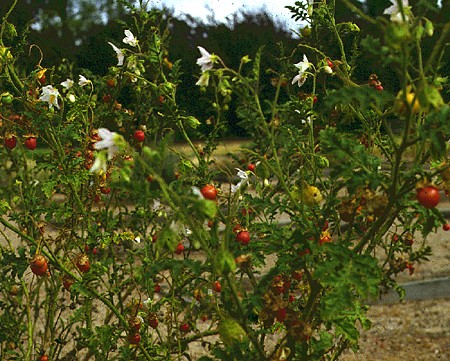 Waite Institute, S.A. Photo: D.E. Symon © D.E. Symon |
 Photo: Charles T. Bryson, USDA Agricultural Research Service, Bugwood.org |
 Photo: Charles T. Bryson, USDA Agricultural Research Service, Bugwood.org |
 Line drawing by M. Szent Ivany J. Adelaide Bot. Gard. 4 (1981) 111, fig. 34. |
 Distribution map generated from Australia's Virtual Herbarium. |

Synonymy
* Solanum sisymbriifolium Lam., Tabl. Encycl. 2: 25 (1794)
T: Described from ?
[S. aculeatissimum auct. non
Description
Erect annual or short-lived perennial herb to 1.5 m, green, pubescent with glandular and stellate hairs; prickles to 13 mm long, abundant on most parts.
Leaves ovate-lanceolate; lamina 5-14 cm long, 4-10 cm wide, concolorous, lobed; lower lobes often forming leaflets; petiole to 4 cm long.
Inflorescence up to 12-flowered; peduncle to 45 mm long; rachis up to 15 cm long; pedicels 10-15 mm long, elongated slightly in fruit. Calyx 6-12 mm long, enlarged in fruit; lobes lanceolate, 4-7 mm long. Corolla stellate, 35-50 mm diam., white or pale blue. Anthers 8-10 mm long.
Berry globular, 15-20 mm diam., bright red. Seeds 2-2.5 mm diam., pale buff. n=12.
A more detailed description of this species can be found at http://delta-intkey.com/solanum/www/sisymbri.htm
Distribution and ecology
Native to warm temperate South America, widely cultivated as an ornamental and occurring as a weed in many countries. Locally naturalised in Qld, N.S.W. and W.A. and possibly Vic.
Common name
Sticky nightshade
Relationships
S. sisymbriifolium remained ungrouped in Whalen's (1984) treatment of subg. Leptostemonum and in Bean (2004) and it also occupied an isolated position within subg. Leptostemonum in the trees produced by Levin et al. (2006).
In a Brazilian study of section Torva, Miz et al. (2008) showed it to be a monophyletic group close to S. melongena and S. sisymbriifolium.
Miz, R.B., Mentz, L.A. & Souza-Chies, T.T. (2008). Overview of the phylogenetic relationships of some southern Brazilian species from section Torva and related sections of “spiny Solanum” (Solanum subgenus Leptostemonum, Solanaceae). Genetica 132: 143-158.
Selected specimens
W.A.: Bayswater, J.M. Graham 3 (PERTH). Qld: Toowoomba, S.L. Everist 7772 (BRI). N.S.W.: Gulargambone, Oct. 1972, D. Smith (NSW).
From the web
Images of S. sisymbrifolium can be seen at http://commons.wikimedia.org/wiki/Solanum_sisymbriifolium and also at www.robsplants.com/plants/SolanSisym.php
Information on this species in NSW can be seen on the PlantNET site.
Information about this species as a weed, together with photographs, can be seen on the Global Invasive Species Database, the Pacific Island Ecosystems at Risk (PIER) page and the South African Weeds & Invasive Plants site.
Further information about this species in the USA can be accessed through the Plants Profile site of the US Department of Agriculture.
Further information, images and links for this species can be found on the Solanaceae Source site.
Ellis Rowan's painting of this species (as S. aculeatissimum) can be seen in the Picture Catalogue of the National Australian Library at http://nla.gov.au/nla.pic-an6723081